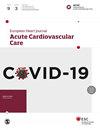对 CULPRIT-SHOCK 试验的贝叶斯再分析
IF 3.9
2区 医学
Q1 CARDIAC & CARDIOVASCULAR SYSTEMS
引用次数: 0
摘要
背景 急性心肌梗死(AMI)、心源性休克(CS)和多血管疾病患者的最佳血管重建策略仍存在争议。CULPRIT-SHOCK 试验比较了单纯罪魁祸首病变与即刻多血管经皮冠状动脉介入治疗(PCI),提供了重要数据,但疗效问题仍未解决。为了解决挥之不去的不确定性并获得更深入的见解,我们对 CULPRIT-SHOCK 试验数据进行了贝叶斯再分析。方法 我们使用非信息先验、怀疑先验和热情先验对 CULPRIT-SHOCK 试验数据进行了贝叶斯再分析。计算了具有 95% 最高后验密度区间的相对危险度 (RR)。我们将最小临床重要差异(MCID)定义为 RR <0.84。我们针对主要患者特征进行了亚组分析,并评估了次要结果和安全性终点。计算了获益概率、达到 MCID 的概率和伤害概率。结果以RR中位数和效应大小概率表示。结果 贝叶斯再分析显示,在非信息先验条件下,中位相对风险为 0.82(95% HPD:0.66-1.04),表明获益概率为 95%,达到 MCID 的概率为 59%。亚组分析显示,男性患者(RR:0.78,达到 MCID 的概率为 73%)、无糖尿病患者(RR:0.76,达到 MCID 的概率为 79%)和非前部 STEMI 患者(RR:0.74,达到 MCID 的概率为 76%)的潜在疗效更强。次要结果表明,死亡率(RR:0.85)和肾脏替代疗法需求(RR:0.72)可能会降低,但复发性心肌梗死(RR:2.84)和紧急血运重建(RR:2.88)的风险会增加。结论 我们的贝叶斯再分析通过量化治疗效果大小的概率,提供了直观的见解,进一步证明了在心源性休克和多支血管疾病的 AMI 患者中,只对罪魁祸首病变进行 PCI 的策略更受欢迎。分析表明,总体获益的概率很高,特别是在特定亚组中,实现最小临床重要性差异的几率也很显著。这些研究结果不仅支持在特定患者群体中考虑仅对罪魁祸首病变进行 PCI 治疗,还强调了对风险-获益进行仔细评估的必要性。此外,我们的假说亚组分析显示了实现 MCID 的不同可能性,为今后在这一重要患者群体中开展有针对性的研究指明了前景广阔的途径。本文章由计算机程序翻译,如有差异,请以英文原文为准。
A Bayesian Reanalysis of the CULPRIT-SHOCK Trial
Background The optimal revascularization strategy for patients with acute myocardial infarction (AMI), cardiogenic shock (CS), and multivessel disease remains controversial. The CULPRIT-SHOCK trial compared culprit-lesion-only versus immediate multivessel percutaneous coronary intervention (PCI), providing important data but leaving efficacy questions unresolved. To address lingering uncertainties and gain deeper insights, we performed a Bayesian reanalysis of the CULPRIT-SHOCK trial data. Methods We conducted a Bayesian re-analysis of the CULPRIT-SHOCK trial data using non-informative, skeptical, and enthusiastic priors. Relative risks (RR) with 95% highest posterior density intervals were calculated. We defined the Minimally Clinically Important Difference (MCID) as RR <0.84. We performed subgroup analyses for key patient characteristics and assessed secondary outcomes and safety endpoints. Probabilities of benefit, achieving MCID, and harm were computed. Results are presented as median RR with probabilities of effect sizes. Results Bayesian re-analysis showed a median relative risk of 0.82 (95% HPD: 0.66-1.04) with a non-informative prior, indicating a 95% probability of benefit and 59% probability of achieving MCID. Subgroup analyses revealed potentially stronger effects in males (RR: 0.78, 73% probability of MCID), patients without diabetes (RR: 0.76, 79% probability of MCID), and those with non-anterior STEMI (RR: 0.74, 76% probability of MCID). Secondary outcomes suggested potential benefits in mortality (RR: 0.85) and need for renal replacement therapy (RR: 0.72), but increased risks of recurrent MI (RR: 2.84) and urgent revascularization (RR: 2.88). Conclusion Our Bayesian reanalysis provides intuitive insights by quantifying probabilities of treatment effect sizes, offering further evidence favoring the culprit-lesion-only PCI strategy in AMI patients with cardiogenic shock and multivessel disease. The analysis demonstrates a high probability of overall benefit, with a notable chance of achieving a minimally clinically important difference, particularly in specific subgroups. These findings not only support the consideration of culprit-lesion-only PCI in certain patient populations but also underscore the need for careful risk-benefit assessment. Furthermore, our hypothesis-generating subgroup analyses, which show varying probabilities of achieving MCID, illuminate promising avenues for future targeted investigations in this critical patient population.
求助全文
通过发布文献求助,成功后即可免费获取论文全文。
去求助
来源期刊

European Heart Journal: Acute Cardiovascular Care
Medicine-General Medicine
CiteScore
8.50
自引率
4.90%
发文量
325
期刊介绍:
The European Heart Journal - Acute Cardiovascular Care (EHJ-ACVC) offers a unique integrative approach by combining the expertise of the different sub specialties of cardiology, emergency and intensive care medicine in the management of patients with acute cardiovascular syndromes.
Reading through the journal, cardiologists and all other healthcare professionals can access continuous updates that may help them to improve the quality of care and the outcome for patients with acute cardiovascular diseases.
 求助内容:
求助内容: 应助结果提醒方式:
应助结果提醒方式:


